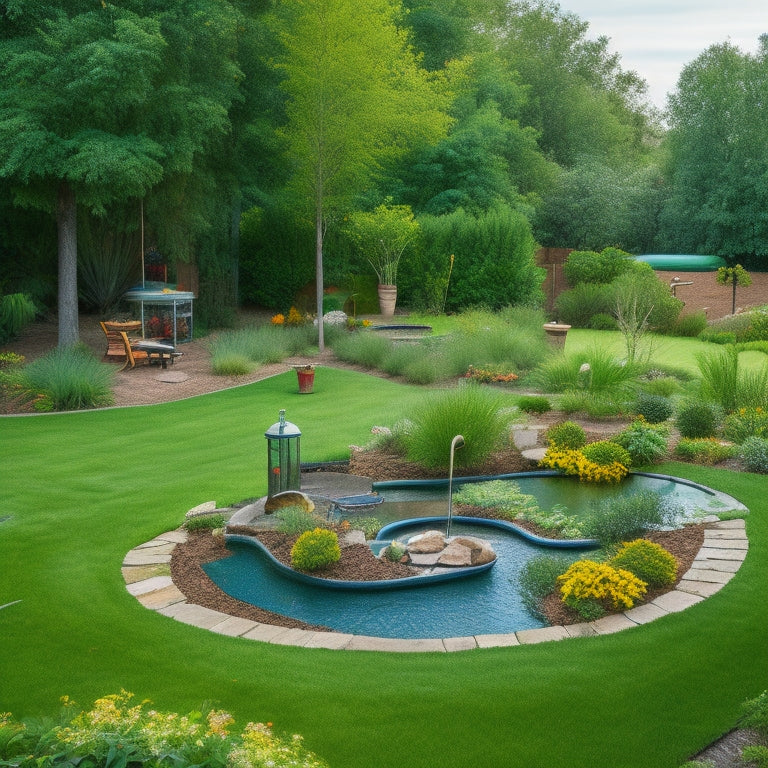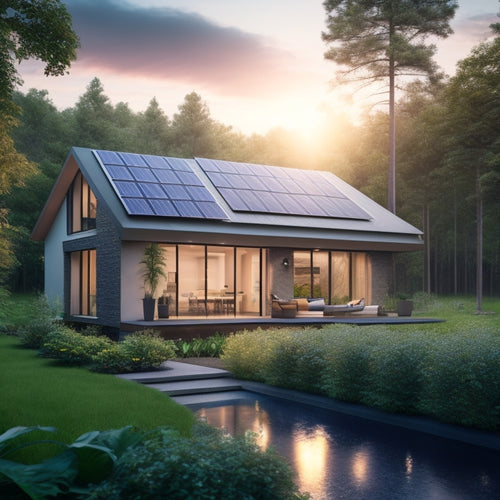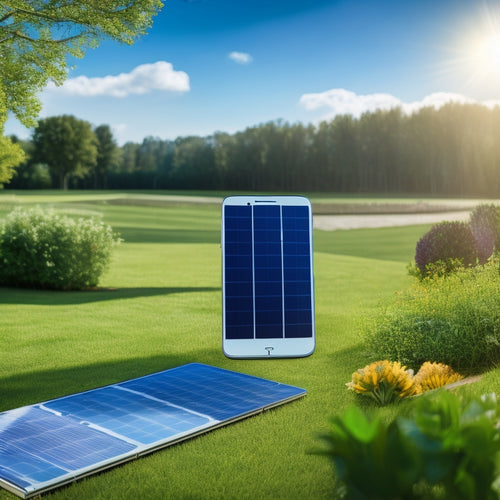
10 Greywater System Installation Costs: Save Money & Water
Share
When installing a greywater system, you'll need to evaluate various costs, including permits and inspection fees, tank costs, plumbing and piping expenses, water treatment unit prices, pump and controller costs, labor and installation fees, maintenance, backwater valve installation, and additional system components. These costs can range from $5,000 to $20,000 or more, depending on the complexity of your system and local regulations. Understanding each of these components and their associated costs will help you save money and water. As you investigate each of these factors, you'll gain a deeper understanding of how to optimize your greywater system for maximum efficiency and savings.
Key Takeaways
- Permit and inspection fees can range from $500 to $2,000, depending on system complexity and local regulations.
- Greywater tank costs vary from a few hundred to several thousand dollars, influenced by material, size, and installation techniques.
- Plumbing and piping expenses can be reduced by using DIY-friendly techniques and decentralized systems, and selecting cost-effective pipe materials.
- Investing in high-efficiency pumps and controllers can lead to long-term cost savings through improved water distribution and reduced energy consumption.
- Regular maintenance is essential for optimal system performance, including inspection and cleaning of filters and monitoring performance.
Permits and Inspection Fees
Compliance with local regulations is a crucial aspect of greywater system installation, and it all begins with obtaining the necessary permits.
You'll need to research and understand the regulatory requirements in your area, which can vary depending on the type of system you're installing and the water usage it will serve.
Similar to commercial EV charging station installations, permits and inspection fees can range from hundreds to thousands of dollars, depending on the complexity of the system and local regulations.
Once you've gathered the required documents, you'll need to submit them to the relevant authorities and wait for approval.
After installation, you'll need to schedule inspections to confirm your system meets the necessary standards.
Inspection processes typically involve a visual examination of the system, verification of proper installation, and testing to verify it's functioning as intended.
Be prepared to pay fees for these services, which can range from a few hundred to several thousand dollars, depending on the complexity of the system and local regulations.
Greywater Tank Costs
Several factors influence the cost of a greywater tank, which can range from a few hundred to several thousand dollars.
You'll need to take into account the tank materials, as they greatly impact the overall cost. For example, concrete tanks are generally more expensive than plastic or fiberglass ones.
Installation techniques also play a significant role, as they can affect the complexity and duration of the installation process. You may opt for a pre-fabricated tank, which can be installed quickly and efficiently, or choose a custom-built tank that requires more labor and knowledge.
In addition, you'll need to take into account the tank's size, as larger tanks require more materials and labor, increasing the cost.
Moreover, integrating renewable energy solutions, such as renewable energy solutions, can also impact the overall cost and efficiency of your greywater system.
Plumbing and Piping Expenses
As you investigate the installation of your greywater system, plumbing and piping expenses become a significant factor to reflect on.
You'll need to take into account the type of pipe materials used, as they can greatly impact system efficiency and water conservation. For example, using PVC pipes can be a cost-effective option, but they may not be suitable for underground installations. Additionally, you'll need to guarantee that your installation meets local plumbing codes, which can add to the overall cost.
When it comes to energy efficiency, high-efficiency panels can also play a pivotal role in reducing operational costs. Furthermore, customizable solar kits can be customized to meet specific energy needs, further optimizing system efficiency.
To save money, think about using DIY-friendly installation techniques and opting for decentralized systems, which require less piping. Proper maintenance, such as regular pipe inspections, can also help reduce long-term costs.
Irrigation System Installation
When installing an irrigation system for your greywater setup, you'll need to evaluate the system design, keeping in mind factors like soil type, slope, and vegetation.
This will help you determine the most efficient water distribution method, such as drip irrigation or sprinkler systems.
You'll also need to choose a distribution method that aligns with your water usage goals and the specific needs of your cultivated area.
Additionally, ensuring a secure and durable installation is vital, much like customization and flexibility in truck-mounted renewable energy solutions, which can withstand environmental loads and provide the best energy output.
System Design Considerations
Properly designing your greywater system's irrigation component requires careful consideration of your terrain's water demands and distribution patterns.
You need to assess your system capacity and user requirements to guarantee it can handle the water flow and distribution needs.
Considering the environmental impact of your system, it's crucial to investigate incentives for sustainable infrastructure, such as federal tax credits for eco-friendly installations.
When designing your system, keep in mind the following key factors:
-
Environmental impact and local regulations: Confirm your system complies with local regulations and minimizes its environmental footprint.
-
Aesthetic considerations and installation location: Choose a location that blends with your surroundings and is easily accessible for maintenance.
-
Material selection and future expansion: Select durable materials and design your system with future expansion in mind, allowing for easy upgrades or modifications.
Water Distribution Methods
Through a carefully planned irrigation system, you can efficiently distribute greywater to your environment, minimizing waste and reducing your water bill.
You have two primary options for water distribution methods: drip irrigation and surface irrigation. Drip irrigation involves conveying water directly to plant roots, reducing evaporation and runoff. Surface irrigation, on the other hand, involves spreading water over the soil surface. Both methods can be effective, but drip irrigation is often preferred for its water-conserving benefits.
When designing your irrigation system, consider your area's integration and system efficiency. By implementing conservation techniques, such as greywater recycling and water reuse, you can minimize your environmental impact while reducing installation costs and saving money on your water bill.
Water Treatment Unit Prices
You'll need to invest in a reliable water treatment unit to guarantee your greywater system operates efficiently and safely. This unit is responsible for removing contaminants and pollutants from the greywater, ensuring it meets the required water quality standards for irrigation and flushing toilets.
A good water treatment unit will also maintain system efficiency, reducing the risk of clogs and backups.
Here are some factors that affect water treatment unit prices:
- Type of treatment technology: Aerobic, anaerobic, and biological treatment systems vary in cost, with aerobic systems being the most expensive.
- System size and capacity: Larger systems require more complex and expensive treatment units.
- Material and construction quality: Units made from high-quality materials, such as stainless steel, are more expensive than those made from plastic or fiberglass.
Pump and Controller Costs
A greywater system's pump and controller play a critical role in guaranteeing the efficient distribution of treated water to irrigation and flushing systems. You'll want to choose a pump with high efficiency to minimize energy consumption and reduce your carbon footprint. The controller is equally important, as it regulates the pump's operation and guarantees that water is distributed correctly.
| Pump and Controller Options | Price Range |
|---|---|
| Basic Pump with Simple Controller | $500-$800 |
| High-Efficiency Pump with Advanced Controller | $1,000-$1,500 |
| Variable Speed Pump with Premium Controller | $1,500-$2,500 |
| Custom Pump and Controller Solution | $2,500-$5,000 |
When selecting a pump and controller, consider the specific needs of your greywater system, including pump efficiency and controller features. By investing in a high-quality pump and controller, you'll enjoy reliable performance and long-term cost savings.
Labor and Installation Fees
You'll need to factor in labor and installation fees, which can vary depending on your location and the complexity of your greywater system.
These costs typically include permits and inspections, which can range from $500 to $2,000, depending on your local regulations.
Your plumber's hourly rate will also play a significant role, with rates typically ranging from $75 to $200 per hour.
Permits and Inspections
How much do permits and inspections add to your greywater system installation cost? As you maneuver through the regulatory requirements for your greywater system, you'll need to factor in the costs of permits and inspections.
These fees vary depending on your location, system size, and complexity.
Here are the typical costs associated with permits and inspections:
-
Permit fees: Expect to pay between $500 to $2,000, depending on the jurisdiction and system size.
-
Inspection fees: You'll need to budget an additional $500 to $1,000 for inspection processes, including multiple site visits.
-
Plan review fees: Some jurisdictions charge an additional $100 to $500 for plan review and approval.
Plumber's Hourly Rate
After factoring in permit and inspection costs, it's time to contemplate the labor and installation fees associated with your greywater system installation. The plumber's hourly rate is a significant component of these costs. This rate varies depending on factors like the plumber's qualifications, location, and type of services provided.
| Plumber's Hourly Rate | Description |
|---|---|
| $75-$125 | Residential plumbers with basic qualifications |
| $125-$175 | Experienced plumbers with advanced qualifications |
| $175-$250 | Skilled plumbers with specialized abilities |
| $250-$350 | High-demand plumbers with extensive experience |
When selecting a plumber, consider their qualifications, plumbing tools, and proficiency in greywater system installation. This guarantees a high-quality installation that meets local codes and regulations, ultimately saving you time and money in the long run.
Greywater System Maintenance
Regular greywater system maintenance is essential to guarantee the system's best performance, prevent potential issues, and prolong its lifespan.
You'll enjoy the greywater recycling benefits and maximize your investment by staying on top of maintenance. The maintenance frequency depends on your system's design, usage, and local regulations.
Here are some essential tasks to perform regularly:
-
Inspect and clean filters: Remove debris and sediment to ascertain efficient water flow and prevent clogs.
-
Check and adjust valves: Verify proper valve function to prevent backflow and ascertain the system operates correctly.
-
Monitor system performance: Keep an eye on water quality, flow rates, and system pressures to identify potential issues before they become major problems.
Backwater Valve Installation
As you confirm your greywater system operates smoothly through proper maintenance, it's equally important to contemplate the installation of a backwater valve.
This device prevents sewage from flowing back into your home, guaranteeing a safe and hygienic environment. You'll need to choose from two primary backwater valve types: a floor-mounted or a sewer-mounted valve. The former is more common, while the latter is suitable for areas prone to high flood risk.
Regardless of the type, routine backwater valve maintenance is essential to prevent clogs and verify proper function. This involves regular inspections, cleaning, and testing to make sure the valve is operating correctly.
Additional System Components
You'll need to take into account several additional components to guarantee your greywater system operates efficiently and effectively.
Pumps and lifting devices, for instance, can help overcome gravity and transport greywater to its destination, while tank and valve options can provide flexibility in system design and operation.
Filter and treatment units can also be added to remove contaminants and improve water quality.
Pumps and Lifting Devices
Greywater systems often require pumps and lifting devices to facilitate the flow of treated wastewater from the treatment unit to the irrigation or disposal area, especially when the terrain or piping layout necessitates overcoming elevation changes or pressure losses.
You'll need to evaluate various factors when selecting a pump or lifting device, including:
-
Pump types: Centrifugal, submersible, or diaphragm pumps, each with its own strengths and weaknesses.
-
Lifting capacity and installation location: Confirm the pump can handle the required flow rate and pressure, and is installed in a location that minimizes energy consumption and maintenance.
-
Energy efficiency, maintenance requirements, and noise levels: Look for pumps with high energy efficiency, low maintenance requirements, and minimal noise levels to save you money and hassle in the long run.
Tank and Valve Options
The treated greywater must be stored in a tank before it's distributed for irrigation or disposal, and valve options play an important role in managing the flow of this water.
You'll need to choose from various tank types, such as plastic, concrete, or steel, each with its own advantages and disadvantages. Consider factors like durability, corrosion resistance, and cost when selecting a tank.
Valve mechanisms are equally vital, as they control the flow of greywater into the tank and out to the irrigation system.
You'll need to decide on valve types, such as float valves, solenoid valves, or diaphragm valves, based on factors like flow rate, pressure, and automation requirements.
Filter and Treatment Units
As your greywater system begins to take shape with a storage tank and valve mechanisms in place, it's time to reflect on the next critical components: filter and treatment units.
These components play an essential role in removing contaminants and pollutants from greywater, making it safe for irrigation and other non-potable uses.
You'll need to contemplate the following filter types and treatment methods for your system:
- Mechanical filters: Remove suspended solids and debris through physical barriers, such as screens or mesh.
- Biological filters: Employ microorganisms to break down organic matter and remove pollutants.
- Chemical treatment units: Use chemicals to disinfect and remove impurities from greywater.
When selecting filter and treatment units, take into account factors like flow rate, water quality, and maintenance requirements to guarantee your greywater system operates efficiently and effectively.
Frequently Asked Questions
Can I Install a Greywater System in an Existing Home?
You can install a greywater system in your existing home by evaluating system requirements, such as water usage and plumbing layout, and managing the installation process, which may involve retrofitting pipes and adding treatment components.
Is Greywater Safe for Vegetable Gardens and Fruit Trees?
You'll be interested to know that 70% of residential wastewater can be reused as greywater! When used correctly, greywater benefits your vegetable gardens and fruit trees by improving soil health, and you can enjoy the freedom of reduced water bills and a thriving harvest.
How Often Should I Inspect and Clean My Greywater System?
You should inspect your greywater system every 1-3 months, depending on usage, and clean it quarterly to guarantee proper greywater maintenance, preventing clogs and backups, and maintaining ideal system performance with regular inspection frequency.
Will a Greywater System Increase My Property Value?
Installing a greywater system is like adding a shiny new jewel to your property's crown, enhancing its appeal and resale value; you'll attract eco-conscious buyers and see a significant increase in your property's worth, giving you the freedom to sell or refinance with confidence.
Can I Connect My Greywater System to a Septic System?
You're considering connecting your greywater system to a septic system. Check local greywater regulations, as they vary; some allow direct connections, while others require separate disposal fields. Verify septic compatibility to avoid system overload and maintenance issues.
Related Posts
-

3 Best Eco-Grants for Home Energy Upgrades
You're eligible for various eco-grants that can help you cut down on energy bills and reduce your carbon footprint by...
-

Why EVs Inspire Earth-Conscious Home Design Choices
As you shift to an electric vehicle, you're not just switching to a greener ride, you're igniting a broader commitmen...
-

7 Best Solar Panel Upkeep Apps for Homeowners
You can optimize your solar panel's energy output and efficiency by up to 20% with regular maintenance, which is wher...


